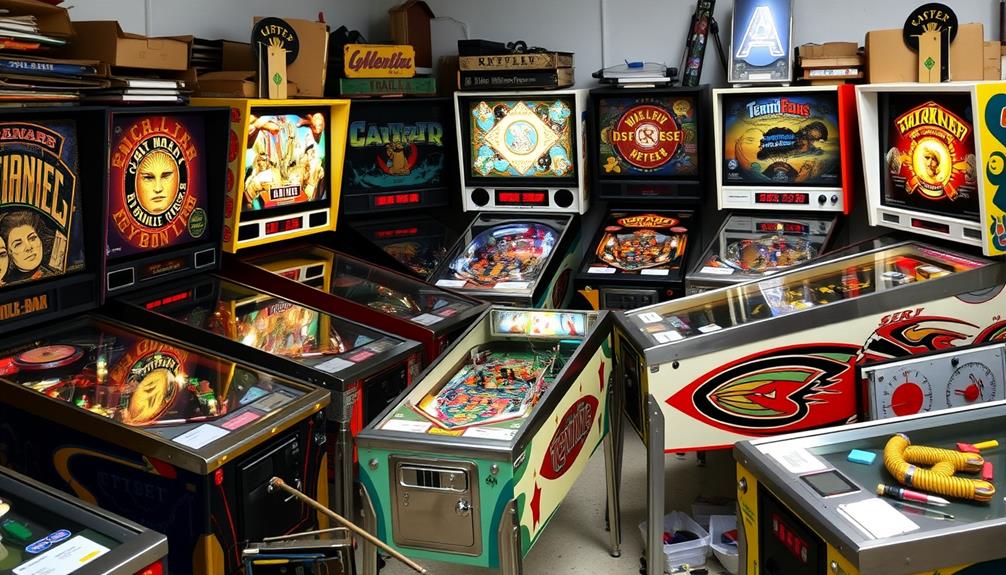Pinball machines may experience varying frequencies of breakdowns, depending on the model, frequency of play, and maintenance level. For instance, the Metallica Pro machine can endure thousands of plays with only minor issues, while the Ghostbusters machine may require repairs after approximately 300 plays. In public settings, wear and tear can escalate, resulting in more breakdowns. Implementing regular maintenance can help identify problems early on, reducing the risk of major issues. Familiarizing yourself with common issues and recommended practices can help ensure your machine operates smoothly. For more in-depth information regarding specific repairs and maintenance tips, further exploration is encouraged.
Key Takeaways
- Pinball machines can break down after varying play counts, with some models needing repairs after as few as 300 plays.
- Regular maintenance, including cleaning and inspections, significantly reduces the frequency of breakdowns and extends machine lifespan.
- Common issues include flipper malfunctions and mechanical jams, often arising after extensive play or lack of upkeep.
- Public machines face more wear and tear compared to those in private settings, leading to more frequent repairs.
- Repair costs range from $75 to $150 per hour, emphasizing the importance of preventive maintenance to minimize long-term expenses.
Factors Influencing Machine Breakage
When it comes to pinball machines, several key factors influence how often they break down. The machine's title and mechanical complexity play significant roles in determining its durability. For instance, some models, like the Metallica Pro, can endure thousands of plays with minimal repairs, while others may need attention much sooner.
Understanding the balance between creativity and maintenance is essential for ensuring ongoing performance, as emphasized in fostering creative problem-solving approaches.
Regular maintenance is important to keep your pinball machine in top shape. Neglecting this can lead to common issues like flipper malfunctions and circuit board failures, which can pop up unexpectedly, even after just a few plays.
If you're using your machine in a public setting, expect higher wear and tear, which accelerates breakage compared to machines in private collections.
Mechanical parts can suffer from cold solder issues and jams the more you play, and breakdowns can happen as early as 10,000 plays. Understanding these factors can help you make informed decisions about maintenance schedules and how you use your pinball machine.
Common Issues Encountered

Pinball machines often face a range of common issues that can disrupt gameplay, especially after extensive use. One of the most frequent problems you might encounter is flipper malfunctions, which can severely impact your ability to play.
You may also notice display failures, where the score or animations don't show correctly, leading to confusion during play. Mechanical jams can occur as well, causing balls to get stuck, disrupting the flow of your game. Regular maintenance, much like using essential oils for toothache relief, is essential to prevent these issues from escalating.
Cold solder issues are another common concern, especially after about 10,000 plays, highlighting the necessity of regular maintenance to catch these problems early. Regularly inspecting the connections and solder joints can save you from bigger headaches later on.
While minor fixes like adjusting switches or soldering wires can often resolve these issues, more complex problems, such as node board failures, might require manufacturer replacement.
Knowing these common issues can empower you to troubleshoot effectively, allowing you to perform minor repairs and keep your machine running smoothly.
Frequency of Repairs by Model

When it comes to pinball machines, repair frequency can really differ by model.
You might find that some, like Metallica Pro, hold up well even after extensive use, while others, such as Ghostbusters, might need attention sooner.
This variation in durability can be influenced by factors such as design and best practices for maintenance.
Understanding these model-specific reliability trends can help you anticipate maintenance needs and keep your games running smoothly.
Model-Specific Reliability Trends
Reliability trends among different pinball machine models reveal significant variations in their frequency of repairs.
When you consider investing in a pinball machine, it's essential to understand how each model holds up over time. Regular maintenance and care can also contribute to a machine's longevity and performance, similar to how cold medications can be selected based on symptoms.
Here's a quick look at some popular models:
- Metallica: Known for its durability, Metallica Pro machines rarely face issues even after 700 plays. With around 5000 plays, users report only minor switch adjustments.
- Ghostbusters: These machines show moderate reliability, needing minor repairs after about 300 plays, indicating some early issues.
- AC/DC: Premium versions typically require adjustments around the 2500 play mark, highlighting that repairs may become more frequent with extended use.
- Star Wars: As a newer release, reliability trends for Star Wars machines are still being evaluated, so detailed data isn't available yet.
Common Breakdown Patterns
Understanding common breakdown patterns in pinball machines can save you time and money in the long run. Different models exhibit varying frequencies of repairs, with some machines performing exceptionally well while others fall short. Here's a breakdown of common issues you might encounter:
For example, a common issue in many pinball machines is a faulty flipper. This can be caused by worn out coils or loose connections. Another frequent problem is a malfunctioning bumper or target, which can be a result of worn out rubber or broken sensors. By understanding these common breakdown patterns, you can stay ahead of potential issues and prioritize pinball machine maintenance to keep your game running smoothly. Regular inspections and proactive repairs can help extend the lifespan of your pinball machine and prevent costly downtime.
| Pinball Machine Model | Frequency of Repairs (Plays) |
|---|---|
| Metallica Pro | 5000 |
| AC/DC Premium | 2500 |
| Ghostbusters | 300 |
| Star Wars | Still Evaluating |
As you can see, machines like Metallica Pro boast durability, often needing minimal repairs. In contrast, Ghostbusters tends to require attention early on, with frequent mechanical jams and circuit board failures. Regular maintenance is key; it can prolong your machine's lifespan, helping you avoid breakdowns even after 10,000 plays.
Maintenance Strategies to Reduce Breakdowns

How can you keep your pinball machine in top shape and minimize breakdowns? By implementing effective maintenance strategies on a regular basis, you can guarantee your machine runs smoothly for years to come.
Additionally, being aware of common financial terms related to maintenance costs can help you budget effectively for repairs and upkeep.
Here are four essential tips to help you maintain your pinball machine:
- Clean Your Pinball Machine: Perform routine cleaning every 2 to 90 days, depending on usage. This prevents dust accumulation that can damage sensitive moving parts.
- Inspect and Replace Worn-Out Parts: During your annual maintenance, check for worn-out rubber rings and bulbs. Replacing these parts can stop minor issues from escalating into significant repairs.
- Keep a Maintenance Log: Document your maintenance activities and repairs in a digital log. This helps you track your machine's condition and address potential problems before they worsen.
- Learn Simple Repairs: Familiarize yourself with basic repairs like soldering loose wires or adjusting switches. These skills can save you time and prevent larger issues from developing.
Repair Time and Cost Analysis

Even with diligent maintenance, pinball machines can still encounter breakdowns that require repair. When that happens, it's important to understand the repair time and costs involved. Typically, minor repairs take about 30 minutes to 1 hour, while more complex issues can extend repair time to several days.
Regular tune-ups and checks can help prevent issues, similar to how thematic coherence in album structure enhances the listening experience.
Repair costs generally range from $75 to $150 per hour, and you'll also need to take into account parts replacement costs, which can vary widely based on the specific component being fixed. Before any repairs commence, diagnostic fees may apply, adding to your overall expenses.
However, remember that regular maintenance can help you minimize these costs in the long run.
Factors like the age of your pinball machine, frequency of use, and the complexity of the technology play significant roles in determining both repair time and costs. If you're handy and have some technical knowledge, DIY repairs can save you money, but if the issue is complex, seeking professional assistance is advisable to avoid further damage.
Balancing repair time and costs is essential for maintaining your pinball machine's longevity and performance.
User Experiences and Recommendations

Experiences with pinball machines often reveal a tapestry of reliability and frustration, depending on the model and usage. For instance, while the Metallica Pro can go through 700 plays with minimal issues, the Ghostbusters might need repairs after just 300 plays.
As with any hobby, engaging with a community can also provide support and tips, echoing the importance of community engagement in hobbies. To enhance your ownership experience, consider these recommendations:
- Know Your Machine: Familiarize yourself with the specific model you own. Some machines are known for reliability, while others may have common issues.
- Regular Maintenance: Stay proactive with maintenance to prevent unexpected malfunctions. This includes checking for flipper and display issues.
- Document Everything: Keep a log of your maintenance activities and machine conditions. This documentation can help identify recurring problems, making repairs easier.
- Join the Community: Engage with other pinball enthusiasts online. They often share insights on potential issues and effective maintenance strategies.
Importance of Regular Maintenance

Maintaining your pinball machine is essential for ensuring it remains in top condition and continues to deliver enjoyable gameplay. Regular maintenance checks are critical for identifying potential issues early, preventing larger problems from developing, and extending your machine's lifespan.
By performing routine cleaning, such as vacuuming dust off the playfield and lubricating moving parts, you enhance performance and reduce wear on important machine parts. Additionally, understanding the financial considerations of repairs and maintenance can help you budget effectively for your machine's upkeep, just like planning for financial considerations for elderly care.
It's a great idea to keep a maintenance log to track changes, orders, and the overall condition of your pinball machine. This way, you can stay informed and address any concerns promptly.
Understanding common issues and performing minor repairs—like adjusting switches or replacing worn rubber rings—can save you time and costly professional repairs.
Don't forget to regularly update your machine's software and firmware, as this can resolve many operational issues, ensuring that your pinball machine runs smoothly and efficiently.
Frequently Asked Questions
What Is the Easiest Pinball Machine to Maintain?
If you're looking for an easy-to-maintain pinball machine, consider the Metallica Pro. With minimal issues after extensive play, it offers straightforward repairs and a supportive user community, making maintenance a breeze for you.
Why Were Pinball Machines Banned in USA?
You'd think pinball machines were plotting world domination! Instead, they were banned for supposedly leading to gambling and vice. Concerned citizens believed these innocent games could spark addiction, threatening the moral fabric of society.
Are Pinball Machines a Lot of Maintenance?
Yes, pinball machines require a fair amount of maintenance. You'll need to perform regular checks, clean components, and make adjustments to guarantee peak performance and longevity. It's essential for keeping your machine in top shape.
How Long Does a Pinball Game Last?
Imagine each play as a heartbeat, keeping the game alive. A pinball machine can last anywhere from a few hundred to thousands of plays, depending on care, model, and wear. Regular maintenance's your best friend!
Conclusion
In the world of pinball, machines can be temperamental, like a diva demanding attention. By understanding the factors that lead to breakage and embracing regular maintenance, you can keep your game alive and thrilling. Just as a well-tuned orchestra plays in harmony, a properly cared-for pinball machine delivers endless entertainment. So, invest time in care, and you'll be rewarded with a vibrant game that sparkles like a diamond, bringing joy to every flip and nudge.









